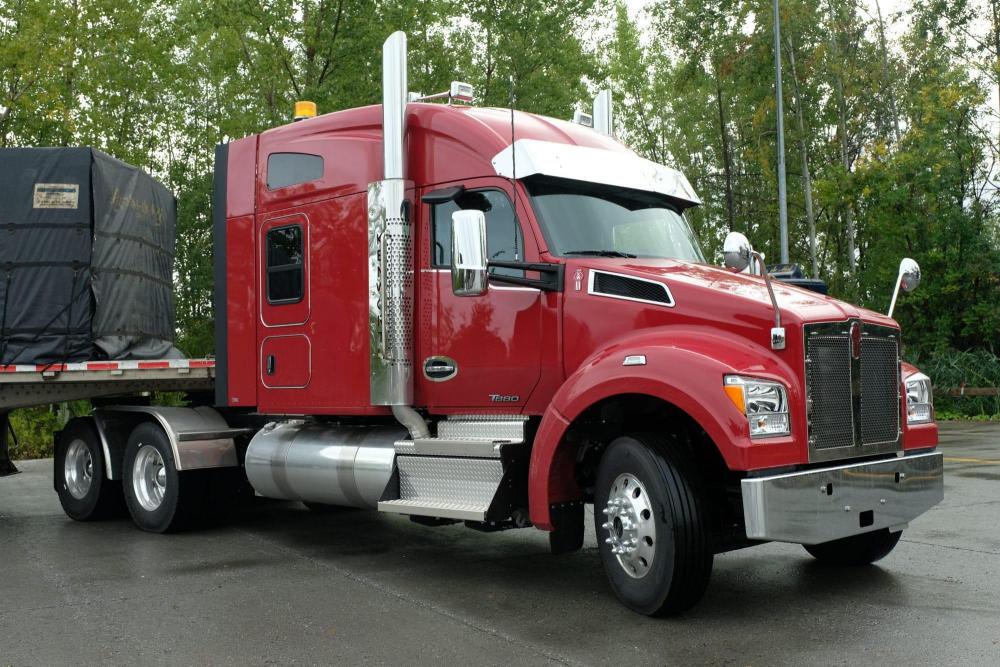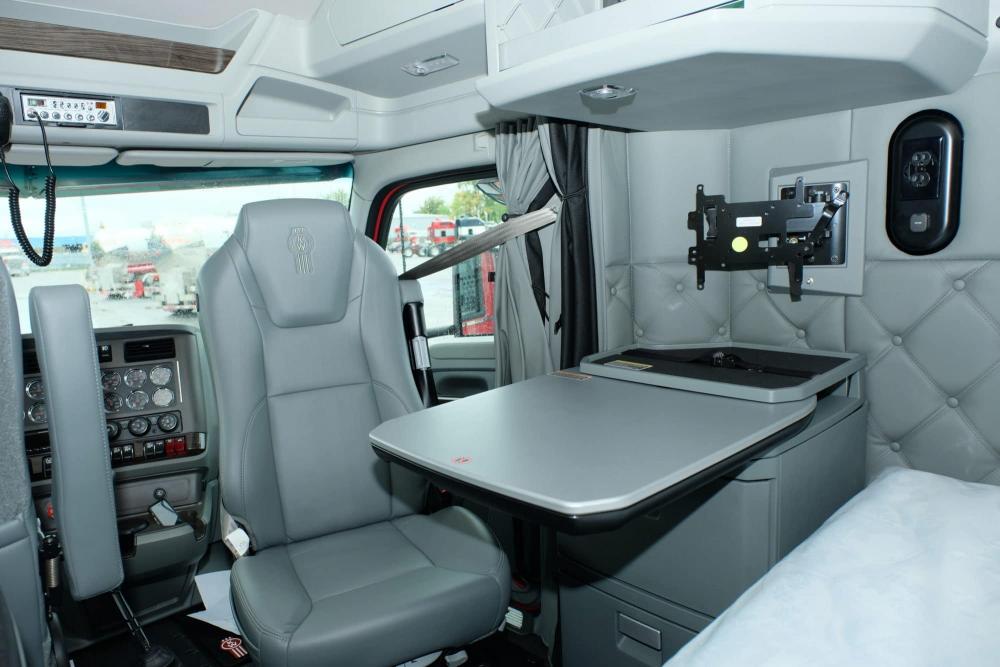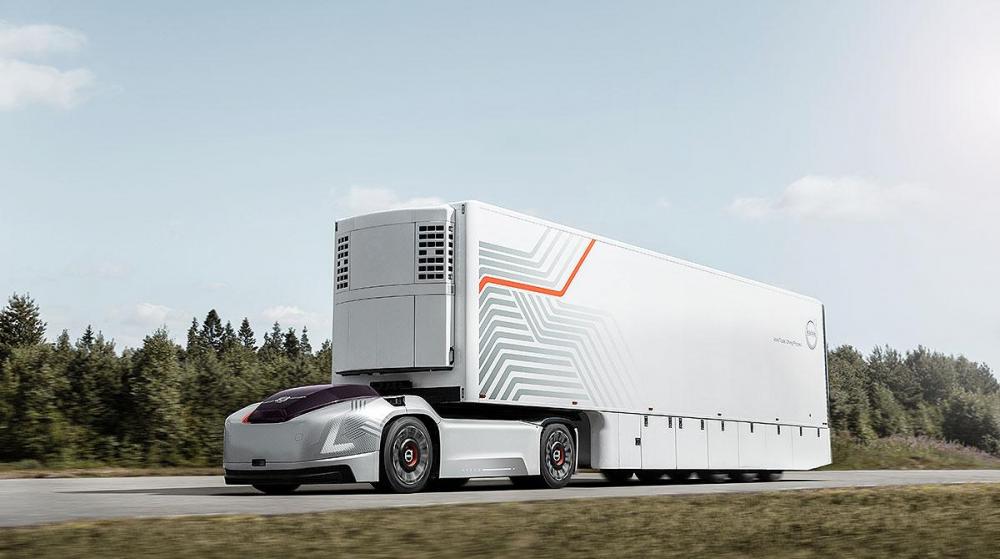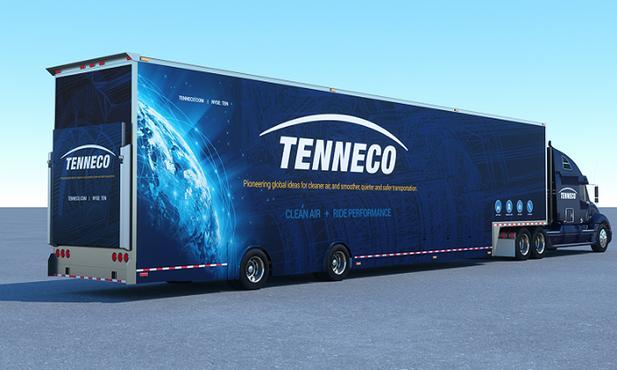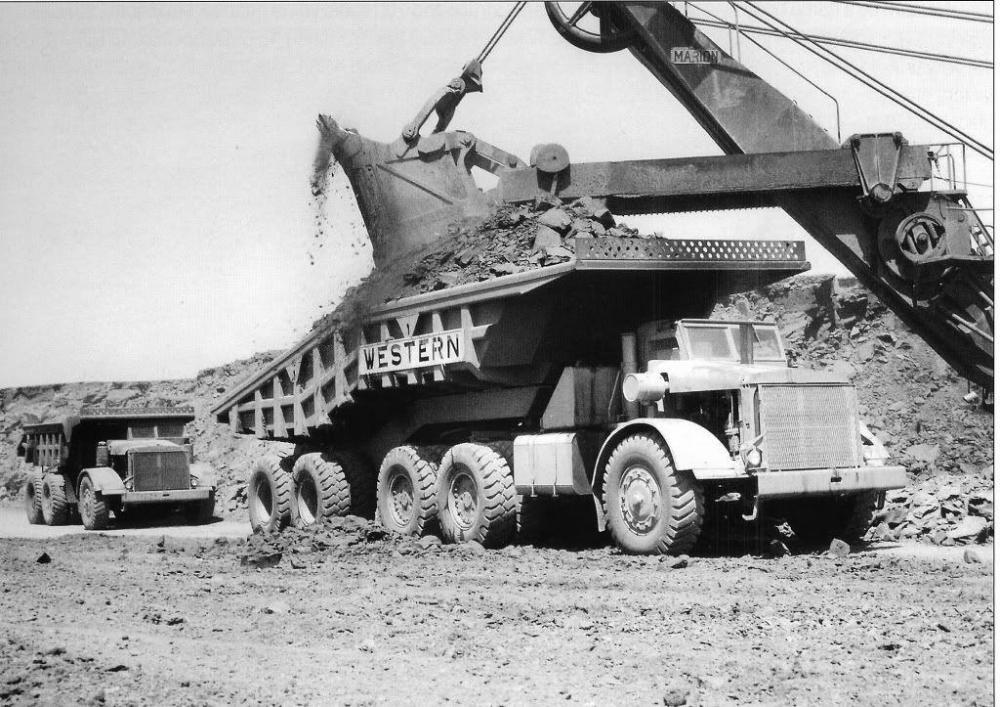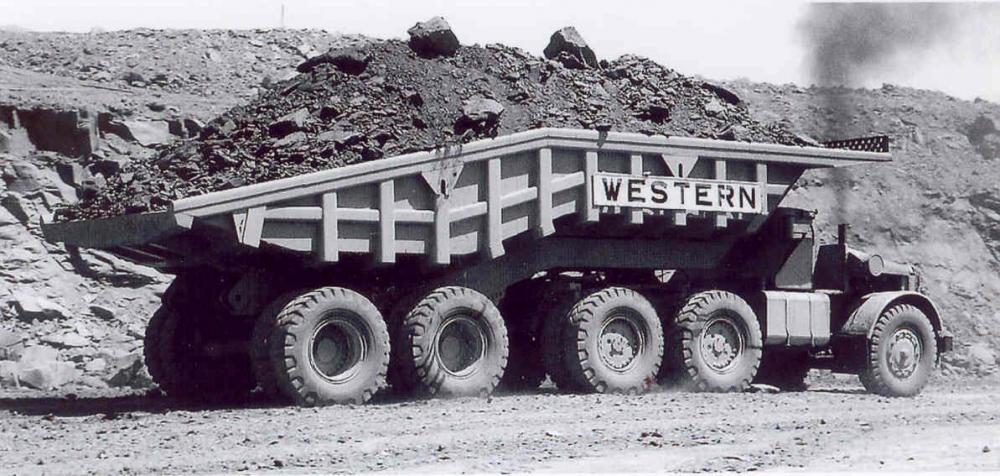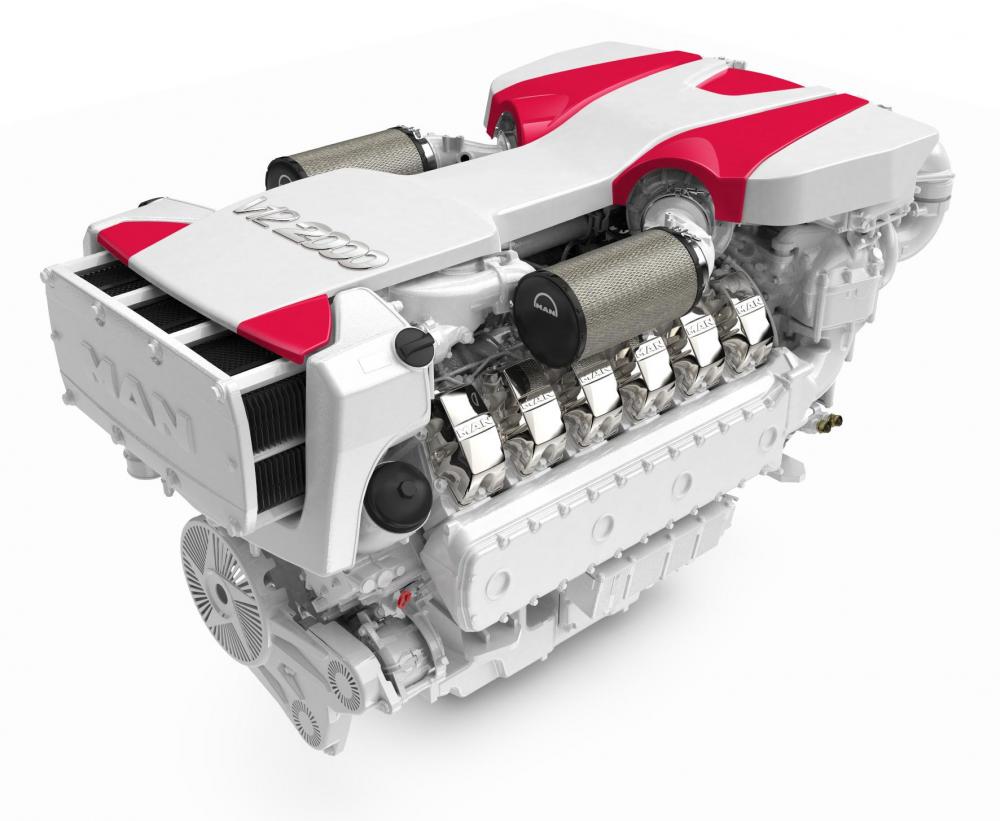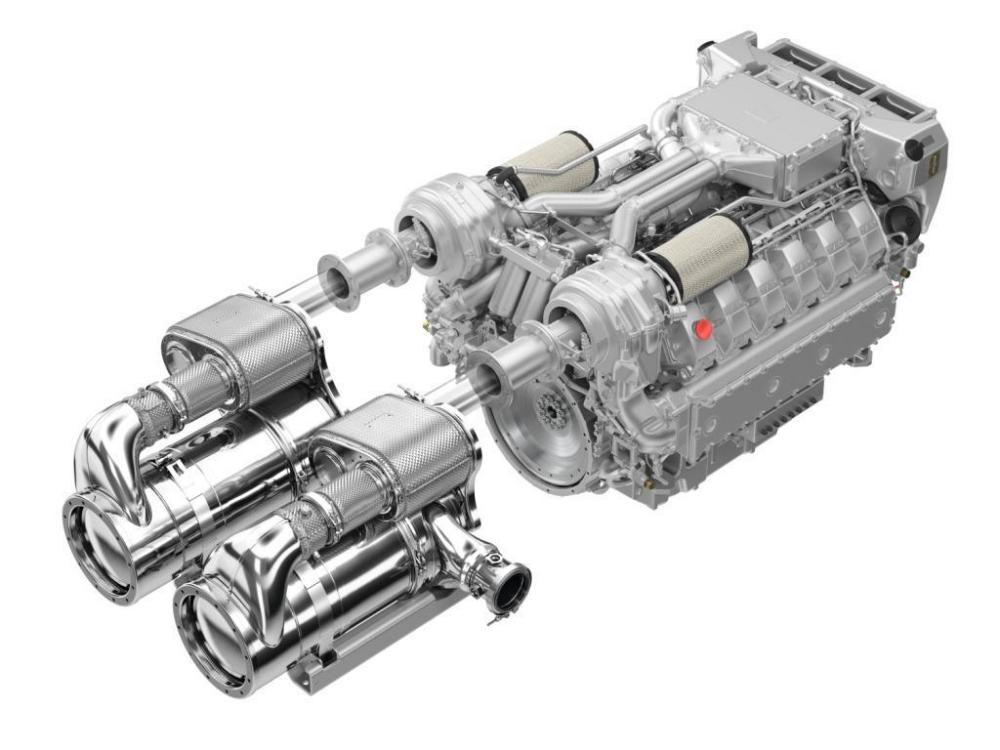
kscarbel2
Moderator-
Posts
18,550 -
Joined
-
Days Won
112
Content Type
Profiles
Forums
Gallery
Events
Blogs
BMT Wiki
Collections
Store
Everything posted by kscarbel2
-
Scania Group Press Release / September 13, 2018 Welcome to Scania Driver Competitions Europe 2018/2019. Find out more at scania.com/driver-competitions .
-
Trump and Immigration (Illegal Immigrants in the US)
kscarbel2 replied to kscarbel2's topic in Odds and Ends
Can someone please tell me why illegal immigrants are being allowed into the country??? . -
Today's Trucking / September 13, 2018 MONTREAL, Que. — While walking the grounds of a small truck show earlier this summer, I spotted this gorgeous red Kenworth along one of the rows of trucks and immediately did a double take. It wasn’t the big 76-inch sleeper that caught my eye, but the set-forward steer axle and squat brawny frontal profile of a T880S. Kenworth offers the T880S variant as a vocational chassis mostly for heavy operators like those in the ready-mix sector who need the extra few inches of axle spacing to meet bridge law requirements in some American states. I didn’t expect to see one here in Canada and I really didn’t expect to see one equipped with a 76-inch sleeper, rigged for on-highway operation. Kenworth says there are only a couple like it and they are both believed to be in Quebec. It’s not often we get what reporters call a scoop on a test drive story, but this test drive is just that: it’s the first time you’ll read about this unique package that I’m predicting soon won’t be so unique. I, and Daniel Paquette, the business development manager at Kenworth Montreal who spec’d the truck, think this will become a popular alternative to the T680 and T880 in some of the more severe Canadian applications where aerodynamics takes a back seat to ruggedness. It was spec’d for a potential tank-hauling customer. Tank trailers typically have a shallow king pin setting, as did the four-axle flatdeck trailer we tested the truck with in Montreal in mid-September. We axle-weighed the load before we left the yard and got the following results — steer axle, 5,120 kg; drive axles, 16,200 kg; trailer axles, 30,820 kg. We were comfortably under the limits all around, but a set-back steer axle might have scaled a bit heavier. According to Paquette, the main reason for putting that truck together was that folks just like the look of the thing. He says he had several requests from his customers to bring one into Montreal so they could have a closer look. “They like the tough, brawny look of the short hood and the set-forward axle,” he told me. I can’t say I disagree Paquette’s customers. (And a thank-you is in order here to Pierre Aubin of L’Express du Midi of Ste-Catherine, Que., for loaning us the flatdeck load of drywall for the test drive. It was a real treat to get a Canadian-weight load to test drive a Canadian-weight truck.) As highway trucks go, this one is a curious mix of rugged and comfortable. It’s spec’d with most of the top-of-the-line driver comfort items like the Diamond VIT interior, swiveling passenger seat and swing-out table, drawer-type fridge, and wiring for a microwave and an inverter. It has the Extreme Temp insulation package as well as a cab heater. Up front we get the full gauge package, and premium seats. In short, just about everything a well-appointed over-the-road truck would have. And under all that is a robust chassis where the heavier components are closer to the top of the list in the data book, like the 2,132,000-lb. RBM frame, heavy-duty crossmembers, 14,600-lb. front suspension, and a 46,000-lb. rear suspension with heavy-duty air springs. The truck is powered by a Paccar MX13 engine cranking out a whopping 510 hp and 1,850 lb-ft of torque. Paquette told me that many of his customers who run loads similar to our test load and even larger B-train loads prefer the 545- and 600-hp Cummins X15 engines with 2,050 lb-ft of torque, but engineering can’t squeeze a red engine beneath the short T880S hood. Still, with it’s million-mile B10 life, two-year, 400,000 km warranty, and a 300-lb. slimmer profile, the MX13 offers a lot in return for what it gives up. Our test drive took us over the Mercier Bridge, and the new bridge over the Beauharnois Canal on Autoroute 30. Both bridges have pretty good grades and forced me to downshift with the MX13, but I suspect I’d have to make that downshift even with the beefier 15-liter engine. The 18-speed transmission gives the driver plenty of latitude to keep the engine where you want it for road speed and torque. On the road Two features of the T880S struck me before we had even left L’Express du Midi’s yard: the maneuverability and the visibility. From the driver’s seat the hood is almost invisible. That provides unprecedented visibility close to the hood, where pedestrians, bicycles and small cars like to hide. The top of the hood at the center is barely chest high, so anyone over four feet tall would be easily seen by the driver. On the right side, just ahead of the A pillar where tall flat hoods and air cleaners once lived, the view down to the side is very good. At a light with a car sitting alongside, the roof was hidden behind the pillar, but the hood and trunk were clearly visible. Score another point for the short, slanted hood. The wheel cut was a bit shy of 50 degrees, Paquette says, owing to the bulkier-than-usual TRW TAS 85 steering box, which is rated for 16,000 lb. It provided wonderfully solid steering at low speeds and out on the highway. My personal feeling is that set-back steer axles can wander a little, but this set-forward axle tracked the lanes like the truck was on rails. Construction on the Mercier Bridge has the lanes narrowed to about 10 feet, so precise steering was pretty welcome there. I tracked right across the bridge about six inches from the barriers on the right with no stress at all. Importantly, I don’t think Paquette was terribly worried either, sitting on the right-hand side and looking out over the abyss. Being a Kenworth, the interior was remarkably quiet. There was no wind noise coming in from around the doors, the engine and transmission noise — aside from those annoying grinding sounds that came up every now and then — was very tame, and even pleasant. It’s funny how fast you get used to some things. Most of the trucks I’ve driven lately have had downsped powertrains, meaning that engine speed at 105 km/h is in the 1,200 rpm range. This truck, with it’s 3.91:1 axle ratio, clearly spec’d for Quebec’s higher weight allowances, was turning about 1,450 at 95 km/h. It seemed fast to me, but that put it right at the upper limit of the MX13’s peak torque band (1,000-1,450 rpm). Given the weight we were pulling, I had to move fast to downshift as it began slipping down lower in the torque band. You lose momentum pretty quickly on a 3% grade at a gross weight of 51,000 kg. In those harder pulls, a rather noisy engine fan spoiled the atmosphere a couple of times. The truck has a 1,330 square-inch rad and a Horton on/off fan, which was obviously adequate for most of the driving we did. Maybe I’m just too used to the light American loads where engines don’t even break a sweat. I’ve saved the best for last here. The ride quality of this truck was sublime. The quality of the ride with the trailer on was unassailable — as solid and sure-footed as you’d expect, but more so. We had to bobtail from Kenworth’s headquarters in Saint-Laurent over to Ste.-Catharine to grab the trailer. That route takes you over some pretty rotten roads, but the suspension really took them in stride. I’m not enough of an engineer to explain it, but I put it down to having the suspension points at the extreme ends of the chassis — there’s no overhanging weight to keep the springs bouncing. It could also be the heavy front and rear suspensions, which you might be inclined to think would provide a rougher ride. I’d call it a stiff ride, but as smooth as I’ve ever felt in a big truck on deteriorating highways. As well, the cab suspension air springs and shocks sit six to eight inches outboard of the frame rails. That wide stance helps discourage cab sway, which can also lead to a wandering steering wheel. It may sound like I’m gushing about this T880S, but I’m not. There’s a lot of good stuff going on here, such as the large rear deck with wide unobstructed access from the right and left sides, even though it sits on a relatively tight 244-inch wheelbase. Or the ease of opening the hood, and the vast amount of space technicians have once they get around the set-forward front wheel. It was a pleasure driving this fairly unique truck for a few hours, and as I indicated earlier, I think we’ll soon see many more of these on Canadian highways. For fans of set-forward axle tractors, it’s a really nice compromise from the long-hood W900. And other people will tell you, it’s just got a certain look. .
-
All-new Ford Trucks tractor-unit is about to hit Western Europe
kscarbel2 replied to kscarbel2's topic in Trucking News
In 2017, Wards Auto says 192,252 heavy trucks were sold in the US. China is the world's largest heavy truck market, almost four times US sales. -
Volvo shows off self-driving, electric truck with no cab
kscarbel2 replied to kscarbel2's topic in Trucking News
Volvo Trucks Develops Autonomous Vehicle Called Vera Transport Topics / September 13, 2018 Volvo Trucks, the manufacturing arm of Volvo Group, underscored its commitment to offering autonomous commercial vehicles in the near future with the announcement recently that it has developed a self-driving, battery-electric, tractor-like unit it calls Vera. Vera is low and sleek, has no space for a driver, and hooks up to a trailer using a fifth wheel and a kingpin. Vera is intended to pull freight in ports, factory areas and large logistics centers where high volume loads are highly repetitive and cover short distances — but additional uses are possible. In the near future, Volvo Trucks’ transport solution will be further developed together with selected customers in prioritized applications, according to a company release. The Gothenburg, Sweden-based truck maker is the second largest in the world, and its other technologies first developed in Europe have migrated to its U.S. brands. For example, its I-Shift automated manual transmission that now has 90% penetration at Volvo Trucks North America, and the platooning technology VTNA demonstrated in June in North Carolina with FedEx Corp. “The full potential of the transport industry is yet to be seen. Everything suggests that the global need for transportation will continue to significantly increase in the coming decade,” said Volvo Trucks President Claes Nilsson in a statement. Growing world population and increasing urbanization are leading to significant challenges to solve environmental issues such as congestion, pollution and noise. Rising consumption, the fast growth of e-commerce and the widespread shortage of drivers put higher demands on efficient transport solutions, according to Volvo. “If we are to meet this demand in a sustainable and efficient way, we must find new solutions. In order to secure a smoothly functioning goods-flow system we also need to exploit existing infrastructure better than currently,” Nilsson said. “The transport system we are developing can be an important complement to today’s solutions and can help meet many of the challenges faced by society, transport companies and transport buyers.” The autonomous electric vehicles will be linked to a cloud service and a transport control center, and equipped with sophisticated systems for autonomous driving — but Volvo did not immediately supply any specific details. They are designed to locate their current position to within centimeters, monitor in detail and analyze what is happening with other road users, such as at intersections, and then respond with high accuracy. The transport control center will continuously monitor the progress of each Vera and monitor each vehicle’s position, the batteries’ charge, load content, service requirements and a number of other parameters. Similar to an industrial production process, Vera’s speed and progress are tailored to avoid unnecessary waiting and to increase delivery precision. In this way Volvo believes it will be possible to minimize waste in the form of buffer stocks of trucks, and increase availability. Vehicles that operate on the same route also will cooperate to create optimal flow. “Our system can be seen as an extension of the advanced logistics solutions that many industries already apply today. Since we use autonomous vehicles with no exhaust emissions and low noise, their operation can take place at any time of day or night,” said Mikael Karlsson, vice president of autonomous solutions at Volvo Trucks. “The solution utilizes existing road infrastructure and load carriers, making it easier to recoup costs and allowing for integration with existing operations.” . -
Crain’s Detroit Business / September 13, 2018 Tenneco Inc's shareholders approved proposals needed for the company's $5.4 billion acquisition of longtime auto parts competitor Federal-Mogul from billionaire investor Carl Icahn. The company said in a statement on Wednesday that the deal has received all necessary regulatory approvals, and they expect it to close Oct. 1. The acquisition is a step toward their ultimate goal of separating back into two new public companies -- one focused on replacement auto parts and the other on powertrain technology. Now, both companies compete in both sectors. The companies said in April that split is expected to happen in the first half of next year. Lake Forest, Ill.-based Tenneco plans to pay for the acquisition with $800 million in cash, about 30 million Tenneco shares and the assumption of debt. Tenneco said the three proposals passed with more than 90 percent of shares voted in favor. After the combined companies split up again, it's expected that headquarters for each company will remain in the Detroit and Chicago areas. The deal marks a payoff for Icahn, who bought up Federal-Mogul debt before the company's 2001 bankruptcy. That debt converted to ownership as part of the company's exit from bankruptcy years later. He increased his stake over time, eventually taking full ownership of the company in 2017 in a roughly $300 million deal after nearly a year of posturing with Federal-Mogul's shareholders. Tenneco posted $9.27 billion in total revenue in fiscal 2017 and reported net income of $274 million. Together, General Motors and Ford Motor Co. comprised more than a quarter of the company's sales last year. Federal-Mogul posted $7.43 billion in total sales in 2016 and $82 million in net income, the latest year available. In 2015 it had a $110 million loss, and a $168 million loss in 2014. None of Federal-Mogul's customers in 2016 accounted for more than 10 percent of its overall revenue, the company said in its annual report. The companies generated a combined $13.67 billion in direct sales with automakers during the 2017 calendar year, not including their vast aftermarket parts businesses, according to the Automotive News list of the top 100 global suppliers. Tenneco ranked No. 32 on that list while Federal-Mogul came in at No. 43. .
-
GM to recall 1.2M pickups, SUVs for steering problem Michael Wayland, Automotive News / September 13, 2018 DETROIT -- General Motors is recalling more than 1.2 million full-size pickups and SUVs globally because of a potential steering problem that could increase the risk of a crash. The automaker says the electric power steering on the affected vehicles can fail momentarily during a drop in voltage and suddenly return, mainly during low-speed maneuvers such as turning. If electric power steering assist is lost and then suddenly returns, the driver may have difficulty steering the vehicle, according to GM. All affected vehicles are from the 2015 model year. In the U.S., which represents more than 1 million of the affected vehicles, the recall campaign includes: Chevrolet Silverado (450,711) and GMC Sierra 1500 (186,083) pickups and Chevy Tahoe (145,198), Chevy Suburban (79,505), Cadillac Escalade and Escalade ESV (45,270) and GMC Yukon and Yukon XL (109,151) SUVs. Nearly 96,000 potentially defective vehicles were sold in Canada. GM, according to company spokesman Tom Wilkinson, is aware of 30 accidents resulting in two injuries because of the defect. No deaths have been reported, he said. The automaker recalled some 2014 model trucks last year for the same problem, including 800,000 Chevy and GMC full-size pickups. The full-size SUVs were not recalled, as they were previous-generation and the problem was not occurring in those models, according to Wilkinson. If power steering assist is lost, a driver information center message may alert the driver to an electric power steering problem. Also, other electrical subsystems may shut down at the same time or just before the event, which could temporarily disable the radio, Stabilitrack stability control system, driver information center, chimes, door-lock cycling, air conditioning or cruise control. GM will notify owners of the affected vehicles and dealers will update the electric power steering module software for free. No date has been set for the recall to begin but Wilkinson said dealers have the updated software packages to fix the problem. He encouraged customers to call their dealers to schedule an appointment.
-
The Euclid 8x4 Prime Movers of F.W. Hake (Hake Rigging)
kscarbel2 replied to kscarbel2's topic in Other Truck Makes
-
Volvo shows off self-driving, electric truck with no cab
kscarbel2 replied to kscarbel2's topic in Trucking News
And neither do I. Why are the US and EU pushing it so hard? -
Volvo Group CEO Lundstedt on Truck Demand and Trade Effects
kscarbel2 replied to kscarbel2's topic in Trucking News
Martin is a wonderful person. Though at Volvo, he'll forever be a Scania man at heart. -
Volvo Trucks Press Release / September 6, 2018 Volvo Trucks has been using connectivity for many years to support customers with efficient service planning. Now technologies are opening up new opportunities to take truck uptime even further. Enabling a deeper, more thorough analysis in real time so that we can predict some potential failures that may otherwise have resulted in an unplanned stop. .
-
Volvo shows off self-driving, electric truck with no cab
kscarbel2 replied to kscarbel2's topic in Trucking News
-
Yes. OM471 = DD13 OM472 = DD15 OM473 = DD16 Power Shift 3 = DT12
-
https://demanddetroit.com/why-detroit/detroit-plant/
-
Fleet Owner / September 12, 2018 Public officials, government agencies, and companies yesterday signed on to a new program to accelerate deployment of zero and near-zero emission commercial vehicles and technologies. The pledge focuses on eight global markets for medium- and heavy-duty vehicles, seeking to achieve commercial success in each of them by 2025 and have zero-emission technology account for the bulk of new sales of these vehicles by 2040. Companies that have signed on include truck manufacturers, utilities, multinational technology developers, and others. The Global Commercial Vehicle Drive to Zero pledge is led by CALSTART, a nonprofit industry organization seeking to reduce emissions from trucks and buses in high-potential markets. The transition to these clean technologies, supporters say, would have significant benefits in lessening the impact of climate change, improving air quality, and promoting public health. "By showing the demand for these vehicles and focusing on the most viable markets, we can accelerate their adoption, improve air quality, and reduce emissions," said John Boesel, president and CEO of CALSTART. If medium- and heavy-duty vehicles can achieve commercial viability in these markets, he added, "we can work to reach economies of scale, bring costs down, and increase adoption throughout the entire medium- and heavy-duty vehicle industry." "Our climate ambition is to reduce emissions with 95% by 2030," noted Oslo, Norway Governing Mayor Raymond Johansen. "By working globally to achieve zero-emission dominance in commercial vehicle sales, we can achieve what would not be possible by working in isolation. I am pleased to announce that Oslo joins that pledge." The California Air Resources Board has adopted the pledge's targeted application approach to advance these technologies in California. The pledge applies this strategy on a global scale, targeting transit buses, shuttle buses, package and delivery trucks, urban box trucks, yard tractors, port-handling equipment, and regional Class 7/8 drayage trucks. In addition to its thousands of fleet vehicles now using alternative fuels, New York City operates more 1,700 plug-in on-road vehicles "and is looking forward to expanding hybrid and electric operations in heavy- and medium-duty trucking," said NYC Dept. of Citywide Administrative Services (DCAS) Deputy Commissioner and Chief Fleet Officer Keith Kerman. The city has also signed on to the pledge and "stands ready to work with public and private fleet partners to advance and expedite this transformation and thanks CALSTART for convening this effort," he added. Signers and supporters of the pledge include: Government City of New York New York State Energy Research & Development Authority California Air Resources Board South Coast Air Quality Management District Bay Area Air Quality Management District Los Angeles Dept. of Transportation Foothill Transit (Greater Los Angeles public transit agency) Elected Officials Los Angeles Mayor Eric Garcetti Sacramento Mayor Darrell Steinberg Stockton, CA Mayor Michael D. Tubbs Oslo, Norway Governing Mayor Raymond Johansen Industry Siemens BYD Mitsubishi Fuso Trucks New Flyer Industries Proterra Southern California Edison Ballard Power Systems Ryder System Chanje Energy Axle Tech Effenco Workhorse Group Orange EV Mayor USA Motiv Power Systems Transpower US Hybrid Lightning Systems Auto Research Institute Viatec XL Fleet West Valley Construction Zenith Motors Unique Electrical Solutions
-
Volvo shows off self-driving, electric truck with no cab
kscarbel2 replied to kscarbel2's topic in Trucking News
-
Reuters / September 12, 2018 Sweden’s Volvo, the world’s second-biggest truck maker, presented a new self-driving electric truck on Wednesday, which it said should help respond to the boom in ecommerce and a shortage of freight drivers. Volvo said the truck, which does not have a driver’s cab, was still under development and declined to say when it would be available commercially. It expects the vehicle to be deployed first in places like ports and large logistics centers. “We believe there will be a driver behind the steering wheel for the foreseeable future, but we will pretty soon see self-drive commercial vehicles in confined areas,” Lars Stenqvist, Volvo chief technology officer, told a conference in Berlin. Trucking is viewed by transport experts as a natural application for self-driving technology because of the relative predictability of highways compared with busy city streets. The cabless truck - which Volvo calls Vera and can pull loads weighing up to 32 tonnes - can be attached to any standard trailer, Michael Karlsson, head of autonomous solutions at Volvo Trucks, said after the vehicle was unveiled. “Vera means faith and we have faith in the future,” Karlsson said, adding the vehicle has a lower operating speed than a normal truck for safety reasons. Guests at the presentation were made to stand behind a barrier as the truck drove out unaided from a tent and were only allowed to approach when it came to a stop. The 1.4-million member International Brotherhood of Teamsters union is campaigning against new U.S. rules to speed the deployment of self-driving trucks, warning they could mean the loss of hundreds of thousands of jobs and hit road safety. However, trucking firms in many countries are finding it harder to attract and retain drivers amid tight labor markets. Karlsson said the truck would allow places like ports that are currently dependent on daytime working hours to run round-the-clock, optimizing the flows of goods and potentially cutting down on stockpiles and increasing productivity. He expects autonomous technology to increase the need for skilled drivers, while cutting down on the need for people to perform repetitive tasks.
-
U.S. producer prices post first drop in one-and-a-half years Reuters / September 12, 2018 U.S. producer prices unexpectedly fell in August, recording their first drop in 1-1/2 years, as declines in the prices of food and a range of trade services offset an increase in the cost of energy products. Despite the surprise weakness in producer prices reported by the Labor Department on Wednesday, overall inflation is steadily rising, driven by a tightening labor market and robust economy. The Federal Reserve is expected to raise interest rates later this month for the third time this year. “Inflation pressures should intensify in coming quarters,” said Ryan Sweet, a senior economist at Moody’s Analytics in West Chester, Pennsylvania. “The unemployment rate is low, GDP growth is above trend, wage growth is accelerating ... and fiscal policy is supportive for the economy.” The producer price index for final demand slipped 0.1 percent last month after being unchanged in July. August’s fall in the PPI was the first since February 2017. That further lowered the annual increase in the PPI to 2.8 percent from 3.3 percent in July. Economists polled by Reuters had forecast the PPI increasing 0.2 percent in August and advancing 3.2 percent year-on-year. A key gauge of underlying producer price pressures that excludes food, energy and trade services edged up 0.1 percent last month. The so-called core PPI gained 0.3 percent in July. In the 12 months through August, the core PPI increased 2.9 percent after rising 2.8 percent in July. The dollar was trading lower against a basket of currencies, while U.S. Treasury prices rose. Stocks on Wall Street were mixed. Declining Margins The correlation between producer and consumer prices has weakened after the government revamped the PPI basket and changed the methodology several years ago. The Fed’s preferred inflation measure, the personal consumption expenditures (PCE) price index excluding food and energy, increased 2.0 percent in July, hitting the U.S. central bank’s 2 percent target for the third time this year. Government data on Thursday is expected to show consumer prices rising 0.3 percent in August after gaining 0.2 percent in July, according to a Reuters survey of economists. There has so far been no widespread price increases from the Trump administration’s import tariffs on lumber, washing machines, solar panels, steel and aluminum, as well as a range of Chinese goods. But with the trade war between the United States and China escalating, economists believe this will change and expect the import duties to boost inflation in the coming months. Recent manufacturing surveys continue to show increases in raw material prices amid growing strains on the supply chain. Wholesale food prices fell 0.6 percent in August, pulled down by sharp declines in the costs of eggs and fresh fruits and melons. Food prices, which dipped 0.1 percent in July, have now decreased for three straight months. Wholesale energy prices rose 0.4 percent in August, with gasoline prices surging 0.6 percent after slipping 0.1 percent in the prior month. Energy prices fell 0.5 percent in July. Overall, the cost of wholesale goods was unchanged in August after edging up 0.1 percent in July. Prices for iron and steel scrap fell 5.6 percent last month, the biggest drop since October 2017. Nonferrous scrap prices decreased 8.7 percent, the largest decline since January 2009. The cost of services slipped 0.1 percent last month, led by a 0.9 percent decline in the index for trade services, which measures changes in margins received by wholesalers and retailers. Services dipped 0.1 percent in July. Over 80 percent of the drop in the cost of services last month was attributed to margins for machines and equipment wholesaling, which fell 1.7 percent. “Declining margins at machinery and equipment firms suggest producers may be struggling to pass on rising input costs related to recent tariffs,” said Sarah House, a senior economist at Wells Fargo Securities in Charlotte, North Carolina. The cost of healthcare services rose 0.3 percent as a 0.5 percent drop in prices for hospital outpatient care was offset by a 0.6 percent jump in the cost of doctor visits, which was the largest gain since June 2010. There were also increases in prices of hospital inpatient and dental care. Healthcare prices ticked up 0.1 percent in July. Those healthcare costs feed into the core PCE price index.
-
Agreed. I see Dodge 4500s and 5500s everywhere, replacing Fords. When I ask the operators how they like them, they have nothing but good things to say. They're not having any problems at all. No doubt, the Cummins ISB is better than the Powerstroke and Isuzu Duramax. Bob, you know Dodge and Ford will have to introduce tilt hoods now on these larger models.
-
All-new Ford Trucks tractor-unit is about to hit Western Europe
kscarbel2 replied to kscarbel2's topic in Trucking News
Well Bob, Bill Ford has shown an immense interest. If not for his personal interest in Ford-Otosan, this truck would not exist today. He personally is behind the continual investment. Politics are politics......business is business. Turkey needs business and Ford needs trucks (and cars). Turkish with jobs (good paying jobs) are happy campers. To understand this product, one has to realize the depths of truck passion and commitment at Ford-Otosan. Bill Ford does. These people have BIG ideas, and are driven only to succeed. -
MAN Truck & Bus Press Release / September 5, 2018 The highest power density on the market: MAN V12-2000; the strongest V8 engine in the yacht sector: MAN V8-1300; world premier at the 2018 Cannes Yachting Festival At the 2018 Cannes Yachting Festival, MAN Engines will debut two new innovations which stand out from their competitors due to their unique nature: MAN engineers have developed the V12-2000, which is the only twelve-cylinder V-engine with 2,000 hp (1,471 kW) to date, which generates enormous power from 24 litres of displacement. Likewise, the strongest V8 engine for yachts and sport fishing boats on the market is the newly introduced V8-1300, which puts forth 1,300 hp (956 kW) from 16 litres of displacement. Both the V12-2000 and V8-1300 engines impress with extremely high power densities of 61 kW and 59 kW respectively per litre of displacement. The minimal space requirement and low weight spell out a clear advantage in terms of ship design, when compared to similarly powerful engines with larger displacement and more cylinders. This is because the installation dimensions of the V12-1900 and the V8-1200 – the formerly highest power levels – have been retained, as they were already compact. These dimensions are 2,159 x 1,153 x 1,272 mm (length x width x height) for the V12-2000, and 1,736 x 1,153 x 1,222 mm (length x width x height) for the V8-1300. The dry weights of 2,380 kg (V12-2000) and 1,880 kg (V8-1300) have also remained the same; through a power increase of both engines, this also contributes to a noticeably lower power/weight ratio of 1.62 kg/kW for the V12-2000, and 1.96 kg/kW for the V8-1300. “With the V12-2000 and the V8-1300 we have set a new benchmark for performance and compactness,” says Claus Benzler, Head of Marine MAN Engines, delighted. Through a series of modifications, MAN engineers have managed a power increase of 100 hp (74 kW) respectively, compared to the previously most powerful V12 and V8 engines from their range. The performance-oriented design is supported by an improved injection system and new turbo charger. This is aided by newly developed cylinder heads and an adjusted cooling system which noticeably provides thermal relief for the engine with its high performance. Additionally, a new crankcase which has been reinforced in significant areas, ensures high performance throughout the entirety of the engine’s long service life. Highly efficient combustion allows the V12-2000 and the V8-1300 to run quietly, as is typical for MAN Engines, and with low fuel consumption. The V12-2000 offers customers the most powerful engine above the V12-1900, the previously most powerful engine, from the MAN Engines range. The superior engine performance allows shipyards to access additional possibilities for equipping larger ship series of around 100 feet with MAN engines. Additionally, as the most powerful V8 engine on the market, the V8-1300 makes it possible to integrate the highest-performing engines into existing applications. “Our MAN engines have always offered performance at the highest level. We currently stand out to a great extent in the market with the V12-2000 and the V8-1300, and will continue as such in the future,” says Benzler. Both engines meet the currently applicable emissions requirements US EPA Tier 3 as well as IMO Tier II, and can thus be operated in all common and popular areas. With the introduction of both new engine types, MAN Engines offers a gap-free power range for yachts from 730 to 2,000 hp (539 to 1,471 kW) for V8 and V12 engines as well as the following inline six-cylinder engines: i6-730, i6-800, V8-1000, V8-1200, V8-1300, V12-1400, V12-1550, V12-1650, V12-1800, V12-1900 and V12-2000. The V12-2000 and the V8-1300 can be viewed from 11 to 16 September 2018 at the Yachting Festival in Cannes on the Jetée 171 and 178 stands. .
-
They can do Case IH Red and New Holland Blue, because they own them.
-
MAN Truck & Bus Press Release / September 4, 2018 Modular exhaust gas aftertreatment with catalytic converter; flexible solution for IMO Tier III as well as US EPA Tier 4 with an optimum space utilization; high packaging density and lightweight MAN Engines will present its solution for meeting the IMO Tier III and US EPA Tier 4 emission standards for commercial use at the SMM in Hamburg: the modular exhaust gas aftertreatment system (EAT). The system sets itself apart with a high level of flexibility and the fact that it is extremely compact, which is ideal in order to meet the various engine room specifications associated with commercial shipping applications. The modular EAT makes a wide range of installation configurations possible as the individual SCR (Selective Catalytic Reduction) components can be positioned differently. Because of this, a flexible system integration, tailored to your specific requirements, can be provided. “By minimizing the system down to just a few components, it stays compact, regardless of its configuration. Thus the system always proves itself as the optimal solution for our customers, even when to be installed in tight engine rooms”, explains Claus Benzler, Head of Marine MAN Engines. However, it’s not just flexibility and compactness that the basically maintenance-free exhaust gas aftertreatment system has to offer – it is extremely lightweight, too. This is also due to the fact that it has fewer components. The centerpiece of the SCR is a catalytic converter which helps to reduce the nitrogen oxides (NOx) in the emissions. In order to do so, a 32.5 percent aqueous urea solution (AdBlue©) is dosed in a SCR mixer and then injected continuously and directly into the exhaust tract. The solution then reacts with the nitrogen oxides and converts them into water (H2O) and harmless nitrogen (N2). This method of SCR injection does not involve compressed air, saving again more space, reducing the technical complexity and installation space required for this already extremely flexible system. In other words, the MAN Engines modular exhaust gas aftertreatment system is a modern SCR-only system, which does without exhaust gas recirculation as well as bulky and heavy components like diesel particulate filters and oxidation catalytic converters. This saves additional costs and makes the system less complex as a whole. Together with the optimized combustion of MAN engines, the SCR catalytic converter meets the requirements of both emission levels IMO Tier III and the US EPA Tier 4. Using the SCR means that specific fuel consumption was additionally reduced by up to 8% per engine while still maintaining the same power. Needless to say that MAN Engines are already known for their impressive fuel efficiency in the industry. Thereby the engineers at MAN Engines achieved to develop an efficient, simple and lightweight exhaust gas aftertreatment system that remains robust and versatile. The foundation of the system is a result of the expertise at MAN Truck & Bus AG, which has successfully been using SCR systems in the group's own trucks in high-volume production since 2006. Furthermore, MAN Engines also benefits from the experience of fitting and installing after exhaust treatment systems gained in the agricultural and industrial sectors. Here the technology has been used since 2015 for in-line and V-engines. Also the SCR system is currently proving its practicality in field trials for commercial work boat applications. As a result, the engines from MAN Engines for work boats are already equipped to meet the IMO Tier III (within NOx ECA North Sea ECA & Baltic Sea ECA) emission standard, which will be mandatory from 2021 on. This standard stipulates a reduction in nitrogen oxides (NOx), depending on the engine’s maximum operating speed, by around 70 percent compared to its predecessor, IMO Tier II. Instead of the 7.7 g/kWh permitted previously, only 2.0 g/kWh will be allowed in the future. At last year’s International Boat Show in New Orleans, LA, MAN launched its SCR system, optimized for work boats and designed to meet the US Tier 4 emissions standard. This standard permits a nitrogen oxide limit value of 1.8 g/kWh and 0.04 g/kWh for particulate emissions, and has been in effect since October 1st, 2017 for all US-flagged commercial vessels with an output of more than 600 kW (816 hp) per engine. This equates to a reduction in nitrogen oxides of almost 68 percent compared to the previous US Tier 3. With its 12-cylinder engines, MAN Engines currently offers a consistent range of outputs from 551 to 1,066 kW for the US Tier 4 emissions standard and up to 1,213 kW for the IMO Tier III emissions standard. This portfolio will be continuously expanded to include other power outputs. MAN Engines will be showcasing its SCR system at the SMM outdor booth # A4.FG10, located between Hall A3 and A4 from September 4th – 7th, 2018. A D2862 12-cylinder engine packaged with a SCR unit will be on display in the atrium, booth # A1.13. .
BigMackTrucks.com
BigMackTrucks.com is a support forum for antique, classic and modern Mack Trucks! The forum is owned and maintained by Watt's Truck Center, Inc. an independent, full service Mack dealer. The forums are not affiliated with Mack Trucks, Inc.
Our Vendors and Advertisers
Thank you for your support!

